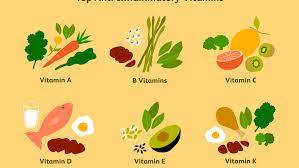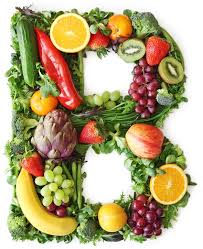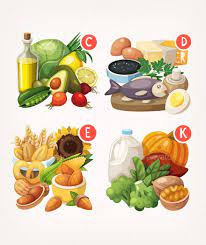I have come across many people that always try pairing foods with vitamins. Either they are in need of a certain vitamin and do not want to take supplements or they just want to eat healthy. I have done some research to find out how many foods with vitamins I can pair for you. Therefore, making it easier for all of you to have all in one place.
Let me start with vitamin A, which is a fat soluble vitamin. This vitamin helps your body with healthy teeth, bones, soft tissue and skin. Beta-carotene is the main nutrient found in vitamin A which helps your eyes adjust to dim light. Vitamin A also stimulates the production of white blood cells, maintains your interior cells healthy, helps your bones and regulates cell growth like in reproduction. It also can help with bacterial and viral infections, prevents night blindness, nail and hair stay healthy. The Recommended Dietary Allowance (RDA) of vitamin A for men 19 years and older is 900 mcg equivalent to 3,000 International Units (IU) and for women 700 mcg equivalent to 2,333 IU. Paring foods with vitamins is a long process. This is a list of food items with vitamin A:
- Egg
- milk
- carrot
- sweet potato
- winter squash
- cantaloupe
- collard greens
- kale
- spinach
Fruits that have Vitamin A are:
- apple, apricot
- banana, blackberry
- cherry
- grapefruit, grape
- kiwi
- lemon, lime, lychee
- mango, melon
- orange
- peach, pear, pineapple, plum, pumpkin
- raspberry
- strawberry
- tomato
- watermelon
Now for those delicious vegetables that have Vitamin A:
- artichoke, asparagus, avocado
- broccoli, brussels sprouts
- cabbage, cauliflower, chicory, corn, cucumber
- green paprika
- leek
- mushroom
- olive, onion
- pea, pickled, potato
- radish, red paprika
- sauerkraut
- zucchini
The above fruits and vegetables for vitamin A also include the following vitamins: B1, B2, B6, C, and Folate (folic acid).
Oh let us not forget some spices which also have vitamin A: paprika, red pepper, cayenne, and chili powder.
Coming Up More Foods with Vitamins
Next comes vitamin B, Did you know there are eight of these? It is true. These vitamins are to help a variety of enzymes do what they do best, from releasing energy from carbohydrates and fat to breaking down amino acids and help transport oxygen and energy-containing nutrients around the body. Finding foods with vitamins is a big challenge. Let us start with this group of finding what foods contain which vitamin.
Vitamin B1
Thiamin aka vitamin B1, it is water-soluble and the liver only stores a limited amount which requires us to eat foods that contain vitamin B1 on a daily basis. This vitamin helps in the growth and function of various cells. The RDA for men ages 19 and older is 1.2 mg and women 1.1 mg, but for women lactating or pregnant 1.4 mg. Now here is a list of foods that have this vitamin:
- Fortified breakfast cereals
- Pork
- Fish
- Beans, lentils
- Green peas
- Enriched cereals, breads, noodles, rice
- Sunflower seeds
- Yogurt
Vitamin B2
Riboflavin aka vitamin B2, the gut produces a small amount of vitamin B2, but more is needed from foods you eat. This vitamin helps with energy, growth of cells, breakdown fats, medication and steroids. RDA for men 19 and older is 1.3 mg, women 1.1 mg, pregnant women 1.4 mg and lactating women 1.6 mg. Below see the list of foods which contain vitamin B2:
- Dairy milk
- Yogurt
- Cheese
- Eggs
- Lean beef and pork
- Organ meats (beef liver)
- Chicken breast
- Salmon
- Fortified cereal and bread
- Almonds
- Spinach
Vitamin B3
Niacin aka vitamin B3, is water-soluble it converts nutrients into energy, create and repairs DNA, create cholesterol and fats and exert antioxidant effects. RDA for men is 16 mg, women 14 mg, pregnant women 18 mg and lactating women 17 mg. Foods with vitamin B3:
- Red meat: beef, beef liver, pork
- Poultry
- Fish
- Brown rice
- Fortified cereals and breads
- Nuts, seeds
- Legumes
- Bananas
Vitamin B5
Pantothenic Acid aka vitamin B5, water-soluble and bacteria in the gut produces some but not enough. This vitamin makes coenzyme A which helps enzymes build and break down fatty acids, as well as to in general synthesize and metabolize proteins, carbohydrates, and fats. RDA men and women 19 and over need 5 mg, pregnant women 6 mg and lactating women 7 mg. Find what foods have vitamin B5:
- Fortified cereals
- Organ meats (liver, kidney)
- Beef
- Chicken breast
- Mushrooms
- Avocado
- Nuts, seeds
- Dairy milk
- Yogurt
- Potatoes
- Eggs
- Brown rice
- Oats
- Broccoli
So Much Information on Foods with Vitamins
Vitamin B6
Pyridoxine aka vitamin B6, water-soluble Pyridoxal 5’ phosphate (PLP) is a coenzyme that breaks down proteins, carbohydrates, and fats to maintain normal levels of amino acids, support immune function and brain health. RDA for men 14-50 of age 1.3 mg, over 51 years 1.7 mg, women 14-18 years of age 1.2 mg, 19-50 years 1.3 mg, over 51 years 1.5 mg, pregnant 1.9 mg and lactating 2.0 mg. Some food sources are:
- Beef liver
- Tuna
- Salmon
- Fortified cereals
- Chickpeas
- Poultry
- Dark leafy greens, bananas, papayas, oranges, and cantaloupe
Vitamin B7
Biotin aka vitamin B7 is water-soluble. Biotin helps enzymes break down fats, carbohydrates and protein in food. It also regulates signals sent from cells and activity of genes. RDA does not have enough information to set a daily requirement, but it does have an AI (Adequate Intake) level which is for men, women and pregnant women of 30 micrograms (mcg) daily and lactating women 35 mcg daily. List of some foods with vitamin B7:
- Beef liver
- Eggs cooked
- Salmon
- Avocados
- Pork
- Sweet potato
- Nuts, seeds
Vitamin B9
Folate (Folic Acid) aka vitamin B9, it is water-soluble and believe it or not, by using a supplement of Folic Acid the body absorbs 85% versus 50% from food. Folate helps form DNA and RNA and helps protein metabolism. It helps break down an amino acid called homocysteine, which can cause harmful effects in the body. Folate helps produce healthy red blood cells, essential for rapid growth during pregnancy and the development of the fetal and helps with anemia. RDA for men and women 19 years and older should take 400 mcg DFE (dietary folate equivalents), pregnant need 600 mcg DFE, lactating 500 mcg DFE and people who drink alcohol should aim for 600 mcg DFE. Folic Acid is better absorbed on foods which vitamin B9 was added, but in the following foods you can find Folate (folic Acid) vitamin B9:
- Dark green leafy vegetables (turnip greens, spinach, romaine lettuce, asparagus, Brussels sprouts, broccoli)
- Beans
- Peanuts
- Sunflower seeds
- Fresh fruit, fruit juices
- Whole grains
- Liver
- Seafood
- Eggs
- Fortified foods and supplements
Vitamin B12
And last but not least, Cobalamin aka vitamin B12 it is water-soluble. This vitamin is needed to form red blood cells and DNA. It helps with the development and function of nerve cells and the brain. RDA for men and women 14 years and over is 2.4 mcg daily, pregnant 2.6 mcg daily and lactating 2.6 mcg daily. List of food sources for vitamin B12:
- Fish, shellfish
- Liver
- Red meat
- Eggs
- Poultry
- Dairy products such as milk, cheese, and yogurt
- Fortified nutritional yeast
- Fortified breakfast cereals
- Enriched soy or rice milk
Vitamin C more on Foods with Vitamins
Ascorbic Acid aka vitamin C , is water-soluble. Vitamin C controls infections and heals wounds, it is a great antioxidant which neutralizes harmful free radicals (electrons). It makes collagen, a protein in the tissue that is present in our nervous, immune, bone, blood and cartilage systems. Also makes some hormones and chemical messengers that are used in our brain and nerves. This vitamin improves your body’s iron absorption, promotes healthy teeth and gums, heals wounds and helps to resist infection. The RDA for men 19 years and older 90 mg daily, women 75 mg, pregnant 85 mg and lactating 120 mg daily. Following is a list of foods which contain vitamin C: The best are fruits and vegetables.
- Citrus (oranges, kiwi, lemon, grapefruit)
- Bell peppers
- Strawberries
- Tomatoes
- Cruciferous vegetables (broccoli, Brussels sprouts, cabbage, cauliflower)
- White potatoes
Vitamin D
Vitamin D is a nutrient that is eaten and a hormone made by our bodies. It is a fat-soluble vitamin which helps the body retain and absorb both calcium and phosphorus to keep our bones healthy and your immune system. It also helps control cancer cell growth (like in colon ), infections and reduces inflammation. The RDA for men and women 19 years and older is 600 IU daily, and for those over 70 years of age 800 IU, but only for those who do not get enough sunlight. Because the best way to get vitamin D is through your skin from the sun.
- Cod liver oil
- Salmon
- Swordfish
- Tuna fish
- Orange juice fortified with vitamin D
- Dairy and plant milks fortified with vitamin D
- Sardines
- Beef liver
- Egg yolk
- Fortified cereals
Vitamin E
Vitamin E is a fat soluble vitamin which has many forms but the one that the body needs is alpha-tocopherol. It acts as an antioxidant trying to eliminate electrons that can cause damage to our cells. It is also good for our immune system and helps prevent clots from getting in our heart arteries. Helps your body use vitamin K to repair your muscle cells. The RDA men, women, and pregnant women age 14 and over need 15 mg equivalent to 22 IU, lactating women need 19 mg equivalent to 28 IU. List of vitamin E foods:
- Wheat germ oil
- Sunflower, safflower, and soybean oil
- Sunflower seeds
- Almonds
- Peanuts, peanut butter
- Beet greens, collard greens, spinach
- Pumpkin
- Red bell pepper
- Asparagus
- Mango
- Avocado
Vitamin K
This is the last foods with vitamins I have for you. Vitamin K is a fat-soluble vitamin that has two forms. The main one is called phylloquinone, this is found mainly in leafy greens and menaquinones is found mainly in the human gut, animal and fermented foods. This vitamin makes proteins to help blood clotting and bone tissue. In our liver, brain, pancreas, bone and heart you can find vitamin K. It can help older people maintain bone health. The RDA for men 19 years of age and older 120 mcg daily, women even those that are pregnant and lactating 90 mcg daily. The list of foods separated by the two forms:
- Phylloquinone -Green leafy vegetables including collard and turnip greens, kale, spinach, broccoli, Brussel sprouts, cabbage and lettuces
- Soybean and canola oil
- Salad dressings made with soybean or canola oil
- Fortified meal replacement shakes
- Menaquinones Natto- (fermented soybeans)
- Smaller amounts in meat, cheese, eggs
Summary of Foods with Vitamins
Boy that was sure a challenge. Hope all the information I have compiled for you can help in your search of foods with vitamins. I am going to summarize a few things.
First of all, the following Vitamins are water-soluble-all the Bs, C, D, E and K. Water-soluble means that the body only takes what is needs and disposes of the rest. Nothing is stored in the body.
Now fat-soluble means the body stores these vitamins in some or our organs, like our liver, pancreas, heart, brain and bones. So no need to take a supplement for those vitamins. Unless your Doctor tells you to do so.
Your body better absorbs the following Vitamins as supplements instead of by the food you eat those are: D, B9 (Folic Acid) and B12. With B12 the best way your body absorbs it more is if you eat fortified foods or supplements in the free form of the vitamin.
Vitamin K is a fat-soluble but it is broken down very fast and eliminated in the urine, so your body never toxic of this vitamin.
There are two kinds of Vitamin D, D2 and D3. Vitamin D2 is produced in plants and fungi while D3 in animals. Of course the best way to get vitamin D3 is through your skin by going out in the sun.
Hope you have enjoyed all the information I have gathered for you
That is all I have for you so far. I hope that the foods with vitamins I have listed here help you out. Oh I also have a page with some great desserts. Enjoy my three favorite recipes.



